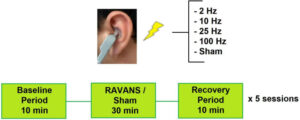Ear stimulation to Lower Blood Pressure: RAVANS or TAVNS
Kristen Sparrow • March 22, 2023


 I’ve been looking at vagal activity with ear stimulation, or transcutaneous auricular vagal nerve stimulation (TAVNS)in the clinic for several years. As readers know, acupuncture calms the stress response by increasing vagal activity. TAVNS should increase vagal activity also. If I can show this, it would give me added confidence in having people use a TAVnS machine at home to help with various conditions i.e. hypertension, anxiety, digestive problems. But more than, lowering stress lowers inflammation which underlies cardiac disease, neurologic diseases, and cancer as well as many autoimmune diseases. Exercise, yoga, breathing all can do this too, but to have a passive way to achieve this would be fantastic.
I’ve been looking at vagal activity with ear stimulation, or transcutaneous auricular vagal nerve stimulation (TAVNS)in the clinic for several years. As readers know, acupuncture calms the stress response by increasing vagal activity. TAVNS should increase vagal activity also. If I can show this, it would give me added confidence in having people use a TAVnS machine at home to help with various conditions i.e. hypertension, anxiety, digestive problems. But more than, lowering stress lowers inflammation which underlies cardiac disease, neurologic diseases, and cancer as well as many autoimmune diseases. Exercise, yoga, breathing all can do this too, but to have a passive way to achieve this would be fantastic.
I don’t want to get into too much detail about this study since it uses a technology that I don’t possess nor do I know if it bestows any advantage to intermittent TAVNS. But of interest to me is
- They found that 100Hz was the most effective frequency for TAVNS in lowering blood pressure and heart rate.
- They saw an improvement in vagal activity with HRV in the period after stimulation also only with 100Hz
I’ve been using 15 hz stimulation because it was said to be the most effective. In other places 2hz. In general, it has been extremely difficult to show any change in HRV with TAVNS but not for lack of trying. I’m continuing to monitor and research this because if we can show efficacy it’s a convenient way for people to reinforce acupuncture treatments at home. It most likely will turn out to be a very individual thing, similar to acupuncture, where one person reacts one way and another person another way. But it seems unlikely that the frequency of stimulation would be personal. It would require a different set up for me to have people rest for 10 minutes after a 30 minute session to see how their HRV reacts, but it wouldn’t be impossible.
Garcia RG, Staley R, Aroner S, Stowell J, Sclocco R, Napadow V, Barbieri R, Goldstein JM. Optimization of respiratory-gated auricular vagus afferent nerve stimulation for the modulation of blood pressure in hypertension. Front Neurosci. 2022 Dec 9;16:1038339. doi: 10.3389/fnins.2022.1038339. PMID: 36570845; PMCID: PMC9783922.
Background
The objective of this pilot study was to identify frequency-dependent effects of respiratory-gated auricular vagus afferent nerve stimulation (RAVANS) on the regulation of blood pressure and heart rate variability in hypertensive subjects and examine potential differential effects by sex/gender or race.
Methods
Twenty hypertensive subjects (54.55 ± 6.23 years of age; 12 females and 8 males) were included in a within-person experimental design and underwent five stimulation sessions where they received RAVANS at different frequencies (i.e., 2 Hz, 10 Hz, 25 Hz, 100 Hz, or sham stimulation) in a randomized order. EKG and continuous blood pressure signals were collected during a 10-min baseline, 30-min stimulation, and 10-min post-stimulation periods. Generalized estimating equations (GEE) adjusted for baseline measures were used to evaluate frequency-dependent effects of RAVANS on heart rate, high frequency power, and blood pressure measures, including analyses stratified by sex and race.
Results
Administration of RAVANS at 100 Hz had significant overall effects on the reduction of heart rate (β = −2.03, p = 0.002). It was also associated with a significant reduction of diastolic (β = −1.90, p = 0.01) and mean arterial blood pressure (β = −2.23, p = 0.002) in Black hypertensive participants and heart rate in female subjects (β = −2.83, p = 0.01) during the post-stimulation period when compared to sham.
Conclusion
Respiratory-gated auricular vagus afferent nerve stimulation exhibits frequency-dependent rapid effects on the modulation of heart rate and blood pressure in hypertensive patients that may further differ by race and sex. Our findings highlight the need for the development of optimized stimulation protocols that achieve the greatest effects on the modulation of physiological and clinical outcomes in this population.

